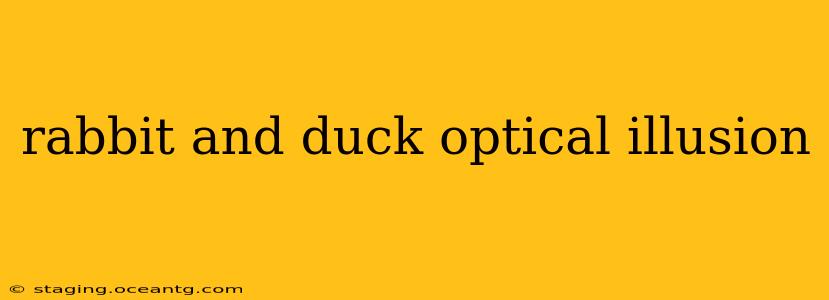The rabbit-duck illusion is a timeless classic in the world of perception, a simple yet powerful example of how our brains can interpret the same visual information in drastically different ways. This seemingly straightforward image—a simple line drawing—can be perceived as either a rabbit or a duck, depending on your perspective. But what makes this illusion so compelling? And what can it teach us about how we see and understand the world around us? Let's dive in.
What is the Rabbit and Duck Illusion?
The rabbit-duck illusion, sometimes called the "Jastrow illusion," isn't a complex, high-resolution image. Instead, it's a simple black-and-white drawing that ambiguously represents both a rabbit's head and a duck's head. The same lines and curves form either animal depending on which way you orient the image in your mind. The illusion highlights the ambiguity inherent in visual perception and how our brain actively constructs meaning from incomplete or ambiguous information.
How Does the Rabbit and Duck Illusion Work?
The magic of the rabbit-duck illusion lies in the brain's interpretive processes. Our brains don't passively receive visual data; they actively process it, filtering and organizing it into meaningful patterns. This process is influenced by prior experiences, expectations, and context. When you look at the image, your brain attempts to make sense of the lines and shapes. Based on your personal experiences and what your brain finds more likely, you'll perceive it as either a rabbit or a duck. There's no "right" answer; both are equally valid interpretations of the same visual stimulus.
Can You Switch Between Seeing the Rabbit and the Duck?
Yes, absolutely! Many people find that they can consciously switch back and forth between seeing the rabbit and the duck by focusing on different aspects of the image. Try focusing on the features that suggest a rabbit (long ears, the body), then shift your focus to the characteristics of a duck (the beak, the head). The ease with which you can switch demonstrates the malleability of our visual perception.
What Does the Rabbit and Duck Illusion Reveal About Perception?
The rabbit-duck illusion is a powerful demonstration of several key aspects of visual perception:
- Ambiguity: The image itself is ambiguous; it doesn't explicitly show either a rabbit or a duck. The meaning is constructed by the observer's brain.
- Top-Down Processing: Our prior knowledge and expectations play a crucial role in how we interpret the image. If you're thinking about farm animals, you might be more likely to see the duck. If you've just seen a cartoon rabbit, you may spot the rabbit first.
- Figure-Ground Relationship: The illusion also highlights the figure-ground relationship in perception – identifying what is the "figure" (the animal) and what is the "ground" (the background). This constantly shifts as you switch between seeing the rabbit and the duck.
- Contextual Influence: The context in which you see the image can also influence your perception. If the image is presented within a wider context that suggests farm animals, you might be more likely to see a duck.
Why is the Rabbit and Duck Illusion So Famous?
Its simplicity and effectiveness make it a popular choice for illustrating the principles of visual perception in psychology textbooks, lectures, and even popular culture. It's a memorable and easily understandable demonstration of how subjective our interpretation of the world can be.
What Other Optical Illusions Are Similar to the Rabbit-Duck Illusion?
There are many other optical illusions that share similarities with the rabbit-duck, playing on similar principles of ambiguity and figure-ground relationships. Some examples include the famous Necker Cube, the Rubin's vase, and the old-woman/young-woman illusion. These illusions showcase the active and constructive nature of our visual system.
The rabbit-duck illusion is more than just a fun brain teaser; it's a window into the complex and fascinating world of visual perception. It highlights the fact that what we see isn't simply a passive reflection of reality, but an active construction of our brains based on a complex interplay of sensory input, prior experience, and context.
